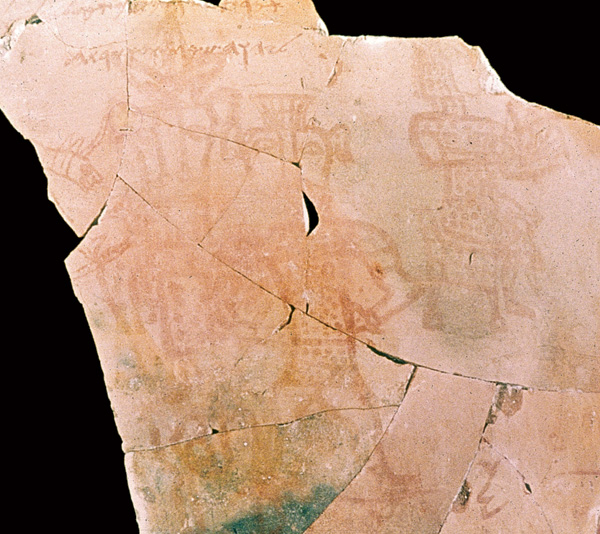Image Details

Photo courtesy of Dr. Ze’ev Meshel and Avraham Hai/Tel Aviv University Institute of Archaeology
TWO BES OR NOT TWO BES. One of the most intriguing and hotly debated drawings from Kuntillet ‘Ajrud is this scene on Pithos A (the relevant fragments of the pithos are pictured here before it was fully reconstructed). According to Pirhiya Beck, who interpreted the drawings for a 1982 article (she has since died), the two main figures on the left are both male. All agree that they are depictions of the Egyptian deity Bes with typical wide-legged stance, arms akimbo, grotesque facial features, feathered headdresses, and only a lion skin for a garment. The seated lyre player at far right fits with Bes’s association with music and dancing. Beck believed that both of the Bes figures are male, despite the apparent breasts and smaller stature of the Bes on the right, because of the lines beneath the noses of both figures, which seem to represent facial hair. Beck interpreted the appendages between the figures’ legs, which appear in the 1982 drawing, as the tails of the lion skin garments they are wearing. But as soot faded from the pottery over time, it became clear that the smaller Bes had nothing between its legs, and the drawing was updated accordingly, this time without the appendage. This may change the whole interpretation of the scene, say the editors of this volume. Some will now see the two Bes figures as a god-and-goddess couple, although the editors of this book do not go so far.
Also visible in the photo is an inscription that runs through the crown of the Bes figure on the left. It reads in Hebrew, “I have [b]lessed you to YHWH [Yahweh] of Shomron [Samaria] and his asherah.” Because it runs through the crown of the Bes figure, it must be dated later.
